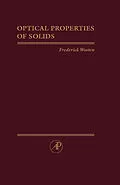Optical Properties of Solids covers the important concepts of intrinsic optical properties and photoelectric emission. The book starts by providing an introduction to the fundamental optical spectra of solids. The text then discusses Maxwell's equations and the dielectric function; absorption and dispersion; and the theory of free-electron metals. The quantum mechanical theory of direct and indirect transitions between bands; the applications of dispersion relations; and the derivation of an expression for the dielectric function in the self-consistent field approximation are also encompassed. The book further tackles current-current correlations; the fluctuation-dissipation theorem; and the effect of surface plasmons on optical properties and photoemission. People involved in the study of the optical properties of solids will find the book invaluable.
Inhalt
Preface
Acknowledgments
Chapter 1 Introduction
1.1 Band Theory of Solids
1.2 Optical Reflectivity
1.3 Photoemission
1.4 Characteristic Energy Loss Spectra
Chapter 2 Maxwell's Equations and the Dielectric Function
2.1 Maxwell's Microscopic Equations
2.2 Maxwell's Macroscopic Equations
2.3 Formal Solutions of Maxwell's Equations
2.4 Analysis of Charge and Current Densities
2.5 Properties of the Medium
2.6 Interaction of Light with the Medium
2.7 External Sources and Induced Responses
2.8 Fourier Analysis of Maxwell's Equations
2.9 The Dielectric Tensor
Problems
Further Reading
Chapter 3 Absorption and Dispersion
3.1 The Lorentz Oscillator
3.2 The Drude Model for Metals
3.3 A Qualitative Look at Real Metals
3.4 Photoemission from Copper
3.5 Quantum Theory of Absorption and Dispersion
3.6 Oscillator Strengths and Sum Rules
3.7 Applications of Sum Rules
3.8 The Absorption Coefficient, Optical Conductivity, and Dielectric Function
Problems
Further Reading
Chapter 4 Free-Electron MetalS
4.1 Classical Theory of Free-Electron Metals
4.2 The Classical Skin Effect
4.3 The Anomalous Skin Effect
4.4 Optical Properties and the Fermi Surface
Problems
References and Further Reading
Chapter 5 Interband Transitions
5.1 Periodic Perturbation
5.2 Direct Interband Transitions
5.3 Joint Density of States and Critical Points
5.4 Direct Transitions in Germanium
5.5 Direct Transitions in Silver: Effects of Temperature and Alloying
5.6 Indirect Transitions
5.7 The Absorption Edge in Ge, AgBr, and AgBr(Cl)
5.8 Excitons
5.9 Direct and Indirect Transitions in Photoemission
5.10 Nondirect Transitions: Photoemission from Cs3Bi
5.11 Transport and Escape Cone Effects on Photoemission
5.12 Photoemission and Electron Transport in Al and GaAs
Problems
Further Reading
References
Chapter 6 Dispersion Relations and Sum Rules
6.1 Linear Response Functions and Kramers-Kronig Relations
6.2 Reflectivity and Phase Shift Dispersion Relations
6.3 Sum Rules
Problems
Further Reading
Chapter 7 Self-Consistent Field Approximation
7.1 Self-Consistent Field Approximation
7.2 Special Cases and Applications
Problems
References and Further Reading
Chapter 8 Current-Current Correlations and the Fluctuation-Dissipation Theorem
8.1 Transition Rate and Current-Current Correlations
8.2 Current Fluctuations
8.3 The Fluctuation-Dissipation Theorem and the Conductivity
Problem
References and Further Reading
Chapter 9 Plasmons and Characteristic Energy Losses
9.1 Single-Electron Excitations in Metals
9.2 Plasmons in Simple Metals
9.3 The Plasmon Cutoff Wave Vector
9.4 Characteristic Energy Loss Spectra
9.5 Surface Plasmons
Problems
References and Further Reading
Appendix A Decomposition of a Vector Field into Longitudinal and Transverse Parts
Appendix B The Local Field
B.l Insulators
B.2 Nonlocalized Electrons
Further Reading
Appendix C Reflection at Normal Incidence
Appendix D The/-Sum Rule for a Crystal
Appendix E Interaction of Radiation with Matter
Appendix F Mx Critical Points
Appendix G Reflectance and Phase-Shift Dispersion Relations
G.1 The Phase-Shift Dispersion Relation
G.2 Numerical Integration of the Phase-Shift Equation
Further Reading
Appendix H k·p Perturbation Theory
Index
